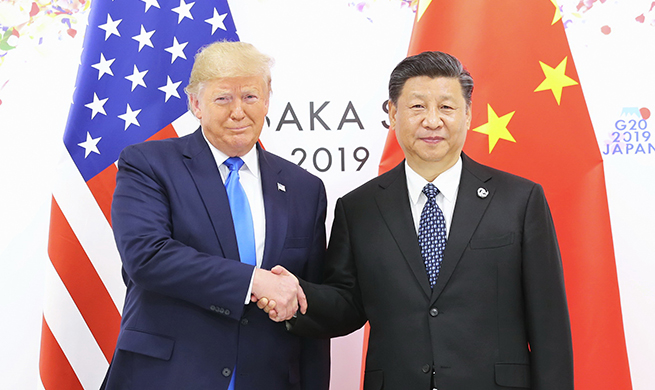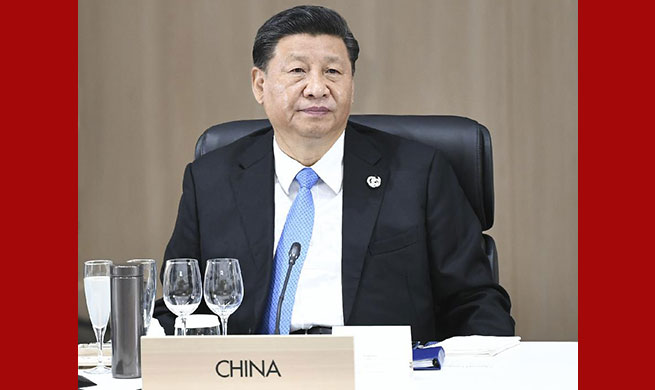NEW YORK, June 30 (Xinhua) -- U.S. equities rallied in June, reversing May's loss as market sentiment was lifted by the central bank's hint on more accommodative monetary policy in the near future.
For the month, the Dow notched 7.2 percent gain, the S&P 500 rose 6.9 percent, and the Nasdaq added 7.4 percent.
June's gains came after the Federal Reserve opened the door for more accommodative monetary policy later this year. The central bank said earlier this month it will "act as appropriate" to maintain the current economic expansion. This lifted market expectations for a July rate cut.
Market expectations for a rate cut now stand at 100 percent, with 71.9 percent chance of a cut of 25 basis points, according to the CME Group's FedWatch tool.
Fed Chairman Jerome Powell reiterated the central bank's stance at its last policy meeting during an event held by the Council on Foreign Relations in New York on Tuesday.
He said the economic situation has changed since the start of May.
"At the start of May, tentative evidence suggested these crosscurrents were moderating, and we saw no strong case for adjusting our policy rate," said Powell.
But the crosscurrents have reemerged after that, with apparent progress on trade turning to greater uncertainty and with incoming data raising renewed concerns about the strength of the global economy, Powell noted.
He said the heightened concerns over trade developments "may have contributed to the drop in business confidence in some recent surveys and may be starting to show through to incoming data."
Against the backdrop of such concerns and uncertainties, the Federal Open Market Committee (FOMC) made significant changes in its policy statement in its June policy meeting last week but did not change the setting for its main policy tool and the target range for the federal funds rate.
"We now state that the Committee will closely monitor the implications of incoming information for the economic outlook and will act as appropriate to sustain the expansion, with a strong labor market and inflation near its symmetric 2 percent objective," Powell said.
Talking about the central bank's future monetary policy move, Powell admitted that he and his colleagues have been grappling with the question that "whether these uncertainties will continue to weigh on the outlook and thus call for additional policy accommodation."
He said many FOMC participants judge that "the case for somewhat more accommodative policy has strengthened. "
But he also warned that monetary policy should not overreact to any individual data point or short-term swing in sentiment.
Matthew Cheslock, equity trader at Virtu Financial, said the biggest impetus for this market move is obviously the reversal in Fed's thinking, especially after a sell-off in May.
He said that the central bank's hint on its next monetary policy move "took a lot of different headwinds that we have out of the picture, one of them being trade."
He added that while the U.S. trade tensions with its major trading partners have caused economic slowdown and lowered companies' earnings forecasts, the trade issue has not really moved the stock market per se as the market is still trading at all time highs.
Market analysts have been forecasting a growth slowdown in earnings from the second quarter to the end of the year.
"We are going to find out how much damage this (trade) has done as we approach the third and the fourth quarter this year," said Cheslock, adding that the equities market will closely monitor the quarterly earnings reports and see how sharp the slowdown in growth will be if trade tensions continue.
"I don't think anyone wants it to continue," he said.
On the economic front, trade uncertainties have clearly weighed on latest batch of economic data and added to market concerns of economic slowdown.
The Conference Board's consumer confidence index, a key measure of the U.S. economy, slipped to 121.5 in June, the lowest since September 2017. The May reading was downwardly revised to 131.3.
The group's present situation index, which is based on consumers' assessment of current business and labor market conditions, decreased from 170.7 to 162.6. The decrease was driven by a less favorable assessment of business and labor market conditions.
The expectations index, which is based on consumers' short-term outlook for income, business and labor market conditions, decreased from 105 last month to 94.1 this month.
Lynn Franco, senior director of economic indicators at The Conference Board, said in a statement that the escalation in trade and tariff tensions earlier this month appeared to have shaken consumers' confidence.
"Although the Index remains at a high level, continued uncertainty could result in further volatility in the Index and, at some point, could even begin to diminish consumers' confidence in the expansion," said Franco.
"It is the first real sign that the recent weakness in the incoming activity data is now spreading to consumers," said Michael Pearce, senior U.S. economist at Capital Economics, in a note.
He said while the fundamentals for consumption growth still appear solid overall, consumption growth will be slowing if the rest of the economy is rapidly losing momentum and taking the jobs market with it.
"If the incoming data continue to deteriorate markedly, the Fed will begin cutting rates, potentially as soon as the July meeting," he said.
The University of Michigan said the final reading of its consumer sentiment index in June was 98.2, slightly higher than economists' expectations, but lower than the 100 reading in May.
Richard Curtin, chief economist of the university's surveys of consumers, said in a statement that June's decline was entirely due to households with incomes in the top third of the distribution, who more frequently mentioned the negative impact of tariffs, cited by 45 percent, up from 30 percent last month.
"Most of the June slippage was concentrated in prospects for the national economy, with the unemployment rate expected to inch upward instead of drifting downward in the year ahead," said Curtin.
In the meantime, the Commerce Department said the U.S. economy grew at 3.1 percent in the first quarter, according to its third estimate.
The figure was in line with the second estimate because the upward revisions to nonresidential fixed investment, exports, state and local government spending, and residential fixed investment were offset by downward revisions to personal consumption expenditures and inventory investment and an upward revision to imports, the department said.
However, some economists saw the 3-percent increase a short-living one, to be followed by a 2-percent increase in the second quarter.
Economic research company Capital Economics said in a report Thursday that it expected U.S. GDP growth to slow sharply for the rest of the year and slow from 2.3 percent in 2019 to 1.2 percent in 2020, before looser financial conditions prompt a recovery to 2 percent in 2021.

















